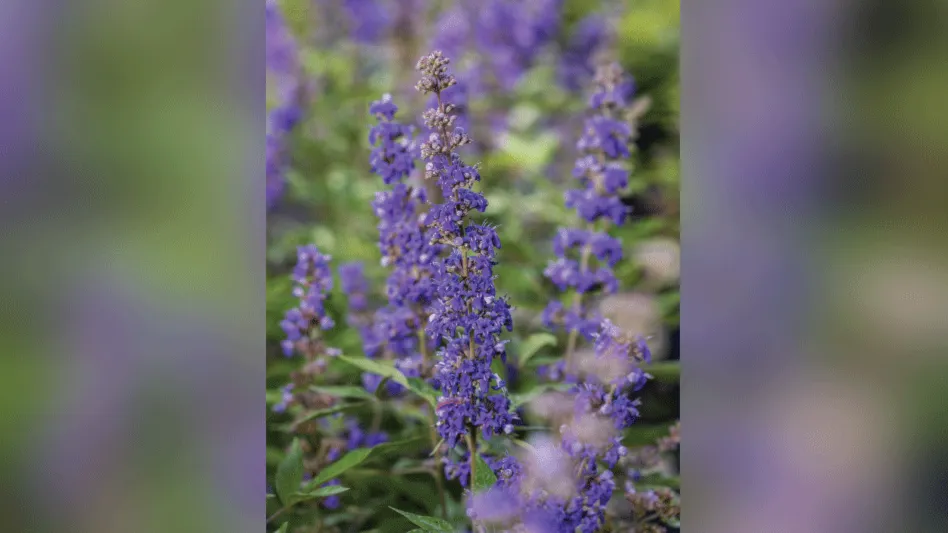
Photos: First Editions Shrubs & Trees
Vitex agnus-castus, or chastetree as it is commonly known, is a large, deciduous shrub and has been a part of landscapes for decades. Often grown as a small tree, Vitex have a somewhat coarse aesthetic, with palmate leaves, light grey branches, and stems that often twist and turn in bonsai-like fashion. The showy panicles emerge in early summer and can be purple, pink, or silvery white, depending on the variety, and are truly beautiful to behold. Vitex can become rather tall over time, as with ‘Shoal Creek,’ an industry standard that easily grows 12-15 feet tall. While chastetrees are often limbed up to expose the trunk and branches, modern cultivars are becoming more restrained in size, making them easier to manage in smaller spaces.

Vitex are incredibly tough plants, naturally drought and salt-tolerant, deer-resistant, and prone to very few pests and diseases. While humans can appreciate their aesthetics, the flowers serve as a food source for an incredible number of North American pollinators despite the plant’s Mediterranean heritage. Every part of Vitex is fragrant, and history is littered with accounts of the leaves being used as an anaphrodisiac, hence the common name, chastetree. Vitex have a naturally long flowering period, with a flush of blooms in early summer that will continue to produce blooms until fall. As with many flowering shrubs, deadheading Vitex will increase the amount and propensity of blooms produced after the initial flush. Speaking of flowers, I can’t think of a single genus that attracts more pollinators than Vitex. Chastetree is the undisputed Queen of the pollinator world, attracting flies, wasps, moths, butterflies, bees, and even hummingbirds to their beautiful panicles.
I’m often asked to distinguish Buddleia and Vitex since the two genera have similar flower types and functions in the garden. While both groups of plants can be interchanged in a variety of landscape settings, there are several ways in which Vitex stand out and deserve recognition for their own merits. Vitex are highly adaptable and remarkably easy to grow. I’ve seen Vitex grown with heavy irrigation and high humidity in Georgia but also seen plants thrive with minimal water in hot, dry environments like Arizona. While they are often considered for southern climates, Vitex is a versatile plant that can adapt to various environments. In regions that experience longer winters than Georgia, Vitex are safe from late frosts because the foliage emerges in late spring. For southern growers, many plants begin to leaf out in March, long before our last frost date. While we protect plants like hydrangea and Lagerstroemia, we can often ignore Vitex during these late frosts because the plant’s limbs are still dormant, naturally dodging the cold snaps. We have trialed our newest Vitex in both Illinois and Minnesota for the last three years and have seen our selections regrow from total stem dieback and then flower throughout mid-late summer.


One of the biggest differences between Vitex and Buddleia can be seen in their water consumption. At Bailey Innovations, we’ve grown butterfly bush and chastetree in the same location and seen big differences in water needs. Vitex remain turgid and healthy-looking in the same conditions that cause Buddleia to wilt and flag. This drought stress can negatively impact Buddleia flowering, but Vitex don’t seem to be phased.
While my love for Vitex is real, I can’t help but feel the genus doesn’t quite get the love it deserves. That’s why we’re working towards refining and improving the characteristics that make Vitex great. First Editions Flip Side, one of our newer Vitex, represents a unique hybrid of Vitex species. Flip Side was originally developed by Dr. Mike Dirr at Plant Introductions, Inc., in Watkinsville, Georgia, and is a hybrid between V. agnus-castus and V. trifolia ‘Purpurea.’ It has olive green foliage with a beautiful purple underside to the leaf. More restrained than either of its wild parents, Flip Side has better cold tolerance than V. trifolia and is much shorter than V. agnus-castus. Flip Side has the added benefit of being completely female sterile. While this sterility provides challenges from a breeding perspective, it’s a welcome bonus in a world where weedy species are becoming more prevalent. New cultivars are coming from Bailey Innovations, with our most recent introduction, the aptly named Queen Bee, available at retail locations this year. Queen Bee is one of the earliest flowering cultivars we’ve ever trialed and it’s a naturally aggressive rebloomer. Queen Bee will max out at about 6.5 feet, making it much easier to incorporate into a landscape.
I can’t say too much about our future introductions, but I can tell you we’ll soon have an even more compact variety that flowers just as quickly and reblooms just as aggressively as Queen Bee. This future introduction will be about 3.5 – 4 feet tall at maturity, making it much easier to work into a border or low hedge. Currently, Vitex flowers are limited to shades of blue, light pink, and silvery white. However, our breeding program has made serious advancements in color expression, with hues rivaling any Buddleia or lilac. The world of Vitex is still relatively small and, in my opinion, underutilized. Still, I hope the improved varieties finding their way to the market help people fall in love with this remarkable genus, as I have.


Explore the April 2024 Issue
Check out more from this issue and find you next story to read.
Latest from Nursery Management
- GardenComm 2024 Annual Conference registration is open
- Landmark Plastic celebrates 40 years
- CropLife applauds introduction of Miscellaneous Tariff Bill
- Greenhouse 101 starts June 3
- Proven Winners introduces more than 100 new varieties for 2025
- CIOPORA appoints Micaela Filippo as vice secretary-general
- Rock Star Roses
- The container challenge





